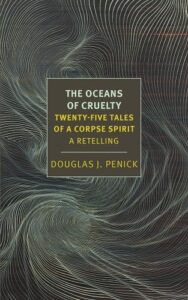Translating the Ancient Language of The Vetala Tales
Douglas J. Penick on Capturing the Essence of South Asian Mythology For a Contemporary Western Audience
I didn’t invent the The Oceans of Cruelty. No one did, but it is something I re-wrote. It just kind of caught me: attracted me and caught me. Because these stories, otherwise known as The Vetāla Tales or Tales of a Corpse Spirit, constitute an ancient—perhaps the most ancient—collection of tales that have come down to us. The version I used was in Hindi, badly translated by some earnest Englishmen in the mid 19th century. The Hindi version had been translated from a much older Sanskrit collection. And this can be traced back, via older and older Sanskrit texts, to a version in Paishachi. This is a truly ancient language which has completely disappeared. It was and is still considered to be the language of the dead and the speech of demons. Yes.
I got into doing this book—or maybe it got into me—because I was in between projects, and I love 1001 Nights. You know, the stories Scheherazade tells her murderous husband to keep herself alive. It’s a delirious immense assemblage of all kinds of tales. Well, I wanted to do something like that. But no one can single-handedly make up that kind of thing. So I looked around. I like re-writing, and I found this cycle on Gutenberg. It’s in the public domain and off I went.
Each story contains other stories, so all of these tales are contained within other, nested, narrative frames, extending out from the beginning of time.But I came to see that these stories, because they go back so far in history and are so deeply buried in consciousness even in their purely linguistic dimension, are haunted. Their origin in ghost language has continued to animate them, even as the stories moved North into Tibet, Mongolia, Buryatsia. The framing story has changed, and the contents have changed. The stories became more about desert people and became more Buddhist. Even now, as they show up here in the industrial consumerist West, we try to control them; we say that they are “literature.” But it seems that they may still be haunted.
In this version of the cycle of the Vetāla tales, Śiva whispers these so seductive stories, and a human lover in bed with his wife happens to overhear them. This husband cannot resist telling these mysterious tales to his wife. Śiva realizes his amorous murmuring have now entered the human realm as common entertainment. He curses the human lover with a terrible curse. This then leads to another story of a King and his successors, and then to a tale about three beings, a Corpse Spirit or Vetāla, who tells the stories, a King—King Vikramāditya—who must comment on them, and an evil yogi who, for his own purposes, set all this in motion; all were long ago fated to come together.
Some of the Vetāla’s tales are fragmentary, some quite complicated, many have repeated and overlapping themes; they take place in throne rooms, charnel grounds, jungles, gardens, shrine rooms and underground caverns. Stories are nested within stories, one set of circumstances is explained by another, in dramas of sudden overwhelming love, terrible grief, of yogis entering new bodies and bringing the dead to life, of faithful guardians and ministers, women with too many fiancées, cruel, murderous husbands, honest thieves, of ritual suicides, of sacrifice, of the power of the Great Goddess to destroy and restore life. Each story contains other stories, so all of these tales are contained within other, nested, narrative frames, extending out from the beginning of time.
As this cycle unfolds, at the end of each story, King Vikramadiya must answer a question which the Vetāla poses about the tale. This, as if these narratives were riddles or puzzles about some larger reality. He answers and then the cycle continues with another story and keeps going until the King cannot think of a reply. Then, the underlying reality of the situation becomes clear. The King and the Vetāla can free themselves from these hallucinatory repetitions.
In all these tales, I think it may be that we can hear the imprint of the speech of demons and ghosts. But I don’t think that it is the out and out weirdness or the magical transmutations of the things described that point to the stories’ haunted origin. To me, it seems far more likely that we hear echoes of an ancient ghost language in the syntax of the stories: in the fractured, and almost jerky narrative, the oblique logic, the elisions and gaps, the incompleteness of how things fit together, the off-balance way things lurch forward, and finally the way we are always poised between things making sense and making no sense at all.
Perhaps these stories also may reflect how the dead remark on living humans, and on activities which they can observe, but no longer influence. Perhaps these are stories of human life refracted in the angle of vision of those neither alive nor human. Perhaps what we are hearing and reading here is the lingering echo of the ways demons talk to each other, how ghosts gossip.
__________________________________

The Oceans of Cruelty: Twenty-Five Tales of a Corpse-Spirit: A Retelling by Douglas J. Penick is available from New York Review Books.




















